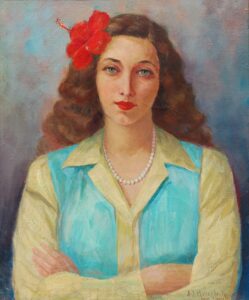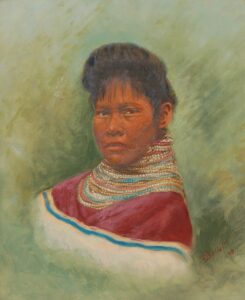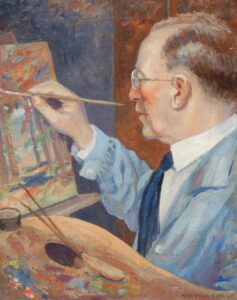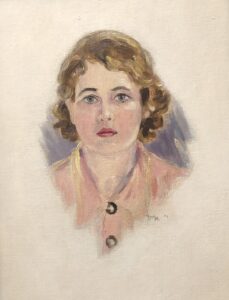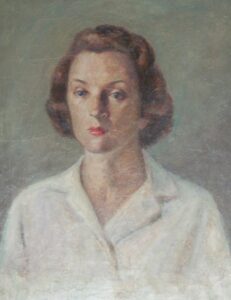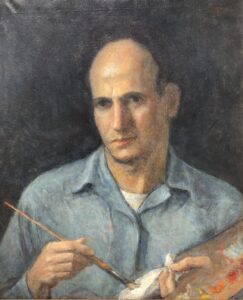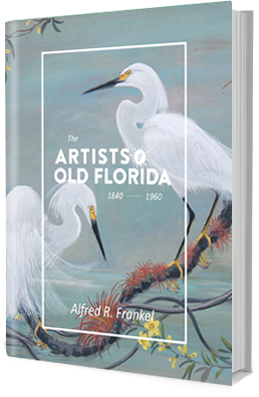Joseph J. Hollenbeck, Palm Beach, Miss Democracy, Girl with Hibiscus, Miss Thelma Jean Miller, oil on canvas, 24 by 20 inches.
From the beginning of the Enlightenment artists ranked the importance of the work they produced. First came the high art of religious or history painting, then landscape, then genre, and finally portrait art. An artist could aspire to be a Leonardo or Botticelli painting universal truths; but to be successful professionally, he or she had to be not only highly competent, but able to earn a living; and long before photography, that meant doing the lowly but necessary work of portraiture.
That judgement about portraiture changed with the artists, and the art loving public’s, recognition that the portrait, while specific and personal, could also be sublime. Rembrandt and Van Gogh are remembered for their penetrating self-portraits. Some of the world’s most famous paintings, The Mona Lisa, The Girl with a Pearl Earring, Whistler’s Mother, are all portraits that only achieved great fame years after they were painted.
My interest in Florida art inevitably led me to find Florida portraiture. The first was perhaps the best. One day, about twenty years ago, I wandered into a West Palm Beach antiques shop to find Frederick von Hausen’s, The Lady with Red Hair. Wow! Here, I thought, was Florida’s Mona Lisa! Well…. not quite La Gioconda, but I loved her smile.
- Frederick von Hausen, The Lady with Red Hair, Palm Beach, 1950. Oil on canvas, 40 by 50 inches.
Later I learned that von Hausen had trained in Vienna at the Royal Academy of Art, and in 1914, just before the onset of World War I, left his home for the United States, and Damariscotta, Maine. A friend suggested that Palm Beach, with its wealth and culture, would be a good winter place to work. He arrived in 1922 in a Lincoln touring car, opened a studio on Worth Avenue and stayed for more than fifty years. Henry Flagler and architect and founder of Boca Raton, Addison Mizner, were among his patrons.
The list of professional portrait artists in Florida in the years between 1840 to 1960 is too long to recount here. There were itinerant traveling portrait artists working in St. Augustine and Tallahassee in 1837-1838 before Florida became a territory in 1840. They came seeking portrait commissions and warm winter weather. The Florida portrait work of William Niblo, Jr. and F. B. Ladd, both from New York, and later the portraits of William McK. Russell, in Tallahassee, are to date, lost, but twentieth century Florida portraits can be found.
Charles Bullet first arrived in Fort Myers for the winter season of 1918. Born in Cincinnati, Bullet lived most of his life across the Ohio River in Campbell County, Kentucky. He painted on Sanibel and Captiva Islands, becoming well known for his early Florida landscapes. But he did portraits as well. The Fort Myers Press, February 17, 1927, carried a notice of an exhibition of his work at the Community House, and the last chance to get one of his fine oil paintings of Florida scenes. He returned home to Fort Thomas, Kentucky, and died suddenly on April 1, 1927, at the age of sixty-three.
Charles Bullet, Seminole Beauty, 1918, oil on canvas,16 ½ by 13 ½ inches.
Mark Dixon Dodd, Self Portrait,1929, oil on canvas, 20 by 16 inches, signed and dated lower right.
Good Florida portraits are not easy to find. Artist self-portraits, even harder. I stumbled on Mark Dixon Dodd’s on eBay. Dodd moved to St. Petersburg from New York City and opened a studio on Beach Drive. He became a prominent member of the city’s art community. In 1933 his mural Seminole War was commissioned by the state of Florida as one of a series of historical subjects for the Florida building at the Chicago Century of Progress.
I found this review of his work in the St. Petersburg Times, April 13, 1930. “Mark Dixon Dodd may be truly called a St. Petersburg artist since for the last few years he has had his house and studio in the city, except for those painting pilgrimages which he has taken from time to time to the west and to the Carolina Mountains. He has a delightful studio and school of art in the picturesque Bayboro section, and is also head of the fine arts department of the St. Petersburg Junior College. Mr. Dodd is showing in the member’s group six oil paintings and nine watercolors. Among the oils, two pictures in the opinion of this reviewer stand out as the best painting this versatile artist has ever done. One is “Self Portrait”, simple, direct, hurriedly done. One of the hardest subjects an artist undertakes. In it Mark has caught something of himself that we all know…”
Theodore Coe, Tampa, Self Portrait, 1924, oil on canvas, 18 by 23 inches.
Theodore Coe was, in his time, a well-known American impressionist, today he is almost forgotten. A friend of the American impressionist John Henry Twachtman, Coe exhibited widely in Boston, New York and Florida, spending his summers on Cape Cod and winters in Tampa. In 1926 he moved permanently to a studio in Tampa. In 1934 Coe was working as an artist for the WPA, and in 1937 he restored a portrait of Colonel John Williams, co-founder of the city of St. Petersburg, and presented it to the city.
In 1957 the Museum of Fine Arts in St. Petersburg presented a retrospective of Coe’s work. Lee Malone, director of the Museum, said of Coe: “The rediscovery of Theodore Coe as a genuine American impressionist–one of that small early band who were much admired by their peers but never quite successful with the public brings the reward of belated satisfaction….It was, in fact, in the middle nineteen thirties that I had first visited his Tampa studio to see them. In these vivid landscapes, especially the tropical scenes of Florida, Coe challenges the usual limitations of the thick oil medium with an immediacy more like the brilliance and dash of watercolor.”
Catherine Stockwell, DeLand. Self-portrait, ME, circa 1910. Oil on canvas, 15 ½ by 11 ½ inches.
Catherine Stockwell was perhaps Florida’s most prolific impressionist artist. Born Catherine Haynes in DeLand in 1895, her father, a DeLand pioneer, had a grocery store on Woodland Boulevard. She attended Stetson University for seven years studying art under landscape artist, and first professor of art at Stetson, Harry Davis Fluhart. Four years after her death the Orlando Sentinel, June 25, 1987, reviewing an exhibit of her work noted: “Stockwell’s obsession with capturing Florida’s pure, swampy landscape during this century was a legend in her native DeLand, which followed her to Eustis. For her there was never enough time to paint it all, the lakes before town houses replaced shacks, the moss-covered trees before they replaced with high-rises. The all-consuming desire to preserve her beloved Florida with smears of color on canvases yielded thousands of paintings and numerous awards for the veteran artist.”
Helen Protas, Sarasota, self-portrait, Voodoo, oil on board, 22 by 26 inches.
Helen Protas, the wife of artist Jay Protas, was known for her, “gay and sometimes humorous modern abstractions.” Her work was noted in Art News, Art Digest, Who’s Who in the South and Southwest and Who’s Who of American Women. By 1951 she had accumulated awards in the National Oil and Watercolor Show, National Watercolor Show, and the Florida statewide experimental show, sponsored by the Sarasota Art Association. Protas exhibited at the Ringling Museum, the Gulf Coast Gallery, Sarasota, and the National Academy of Design. A Canadian, Helen and her husband Jay were killed on the way back to Helen’s home in Hamilton, Ontario when their car blew a tire, crossed the median on the New York State Thruway and was hit by an oncoming truck. Helen, a charter member of Sarasota’s Petticoat Painters, was forty-five.
Paul Laessle, Miami. Self Portrait, oil on canvas, 24 by 20 inches.
Paul Laessle graduated from the Pennsylvania Academy of Fine Arts in 1935, wining the prestigious Cresson Scholarship for travel in Europe. He came from an artistic family with his mother, Mary Middleton Laessle, a professional sculptor and portrait painter, and his father, Albert Laessle, internationally known as a sculptor and a member of the National Academy of Design. The family moved to Miami in 1945.
The Miami Herald noted Laessle in an April 1949 column: “A folding easel, an Austin and the open road. This is a combination that partially explains the quantities of little ‘First Prize’ slogans that have appeared in the last couple of years on the contributions of the Miami painter to group exhibitions. Since he came to Miami four years ago, Mr. Laessle and his ‘painting wagon’ have hit a lot of Florida high spots with the ‘first prize’ results mentioned…But when you paint scenes flooded with Florida sunshine, you need to be out in the sunlight to get the proper affect, this traveling artist believes…So far the principal painting areas have been the Keys and the region about Marco Island, ‘though up Palm Beach way’ has also provided some subject material.” In 1950 Laessle was president of Miami’s prestigious artist group the Blue Dome Fellowship. From 1951 to 1956 Laessle worked as an instructor in portrait painting at the Terry Art Institute. This self-portrait appeared in the June 15, 1952, issue of the Miami Daily News and was one of twenty-five paintings chosen by the Florida Federation of Art for its annual circuit around Florida.
Eloise McWilliams, Self Portrait, oil on board, 22 by 28 inches. Awarded first prize, figures at Miami Womans Club Annual Artists and Writers Breakfast, 1947
Elosie Vail McWilliams studied art at the Cleveland School of Art before moving to Miami and Coconut Grove in 1937. In 1947 her self-portrait won best figure painting at the Miami Woman’s Club Annual Artist & Writers Breakfast. A member of the Florida Federation of Art and Miami’s prestigious Blue Dome Fellowship, she exhibited in Miami into the 1950’s before passing away at her home in Coconut Grove in 1969 at age 82.

Eloise McWilliams. Daydreams, Girl with a Book, oil on canvas, 30 by 36 inches, signed lower right. Exhibited Florida Federation of Art, 19th Annual, Miami Beach, December 7, 1945.
Well, that’s a brief look at Florida portraiture from Palm Beach and Lady with Red Hair to the beginning of the modern woman’s movement in Miami in the 1940’s. The Ringling Museum has portraits by Frans Hals and Rembrandt. Madam X and American Gothic are classical American portraits. I hope this article will stimulate Floridians to find and preserve our own portrait heritage.

